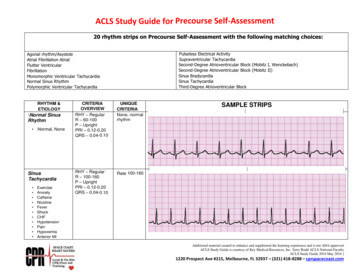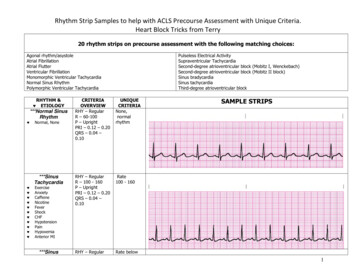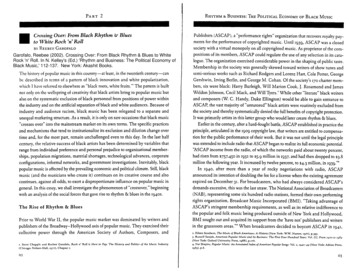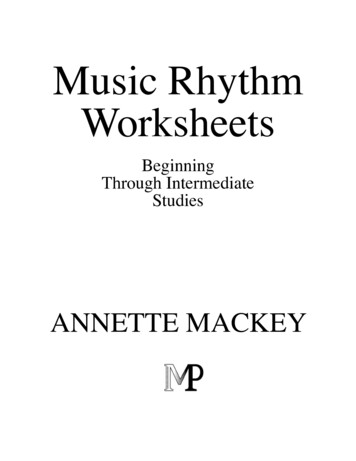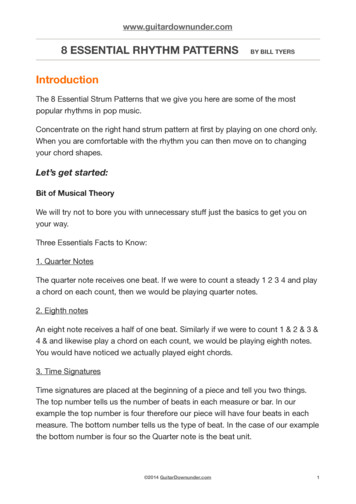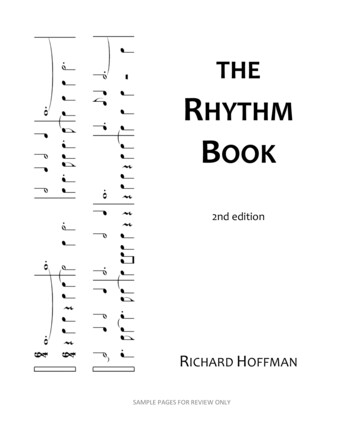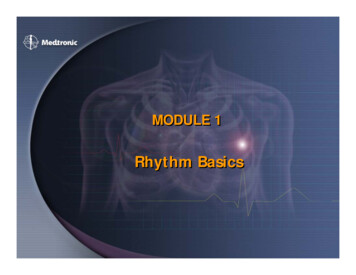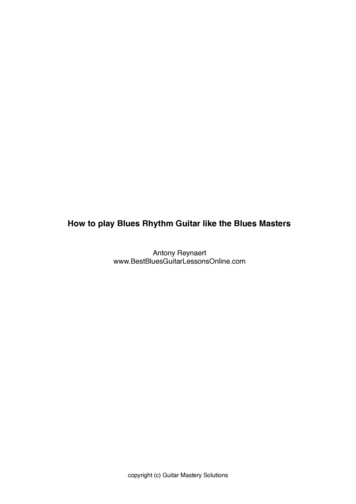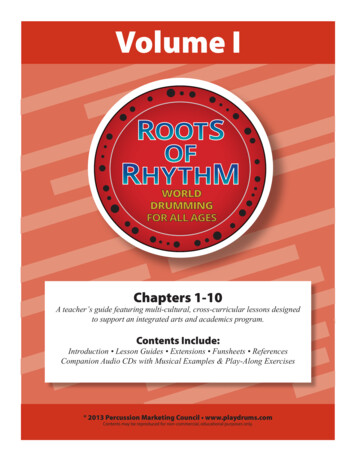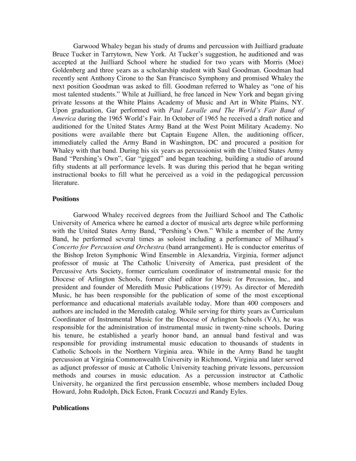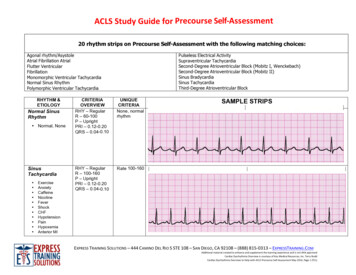
Transcription
ACLS Study Guide for Precourse Self-Assessment20 rhythm strips on Precourse Self-Assessment with the following matching choices:Agonal rhythm/AsystoleAtrial Fibrillation AtrialFlutter VentricularFibrillationMonomorphic Ventricular TachycardiaNormal Sinus RhythmPolymorphic Ventricular TachycardiaRHYTHM &ETIOLOGYNormal SinusRhythm Normal, NoneSinusTachycardia nsionPainHypoxemiaAnterior MIPulseless Electrical ActivitySupraventricular TachycardiaSecond-Degree Atrioventricular Block (Mobitz I, Wenckebach)Second-Degree Atrioventricular Block (Mobitz II)Sinus BradycardiaSinus TachycardiaThird-Degree Atrioventricular BlockCRITERIAOVERVIEWRHY – RegularR – 60-100P – UprightPRI – 0.12-0.20QRS – 0.04-0.10UNIQUECRITERIANone, normalrhythmRHY – RegularR – 100-160P – UprightPRI – 0.12-0.20QRS – 0.04-0.10Rate 100-160SAMPLE STRIPSEXPRESS TRAINING SOLUTIONS – 444 CAMINO DEL RIO S STE 108 – SAN DIEGO, CA 92108 – (888) 815-0313 – EXPRESSTRAINING.COMAdditional material created to enhance and supplement the learning experience and is not AHA approvedCardiac Dysrhythmia Overview is courtesy of Key Medical Resources, Inc. Terry RuddCardiac Dysrhythmia Overview to Help with ACLS Precourse Self-Assessment May 2016, Page 1 [TCL]
ACLS Study Guide for Precourse Self-AssessmentRHYTHM &ETIOLOGYCRITERIAOVERVIEWSinus Bradycardia RHY – RegularR – Below 60 Damage SAP – Upright Normal sleepPRI – 0.12-0.20athletesQRS – 0.04-0.10 SAMPLE STRIPSVagalGlaucomaHypothermiaInferior MIDrugs – MS,digoxin, InderalIICPPVC/PVDPremature VentricularContraction/Depolarization Hypoxia Hypotension Anemia Ischemic heartdisease Electrolytes M.I. Myocarditis,pericarditis CHF Stress, fatigue,smoking, Overeating, caffeine Hypoglycemia Sepsis Cyclic antidepressants SupraventricularAcidosisTachycardia UNIQUECRITERIARate below 60Not visible suddenstart or stopAN ECTOPICBEATRHY – IrregularR – 60-100P – UprightPRI – 0.12-0.20QRS – 0.04-0.10SR, earlybeat hasVent beat(wide &bizarre)RHY – RegularRate aboveR – 160 - 250160-250P – UprightPRI – 0.12-0.20QRS – 0.04 – 0.10EXPRESS TRAINING SOLUTIONS – 444 CAMINO DEL RIO S STE 108 – SAN DIEGO, CA 92108 – (888) 815-0313 – EXPRESSTRAINING.COMAdditional material created to enhance and supplement the learning experience and is not AHA approvedCardiac Dysrhythmia Overview is courtesy of Key Medical Resources, Inc. Terry RuddCardiac Dysrhythmia Overview to Help with ACLS Precourse Self-Assessment May 2016, Page 2 [TCL]
ACLS Study Guide for Precourse Self-AssessmentRHYTHM &ETIOLOGYAtrial Flutter Ischemic heartdiseaseMIDigoxin toxicityMitral, Tricuspidvalve diseaseStressPEHyperthyroidOften tempAtrial Fibrillation Ischemic heartdiseaseDigoxin toxicityCHFMIMitral or Tricuspidvalve diseaseCRITERIAUNIQUEOVERVIEWCRITERIARHY – Regular or Regular orIrregularIrregularR – Atrial 250-400No PsVent: 70 - 150(called Fs)P – None, FsPRI – NoneSaw toothQRS – 0.04-0.10SAMPLE STRIPSRHY – IrregularIrregular, noR – Atrial 350-600No Ps (calledVent. –Fs)Below 100controlledAbove 100uncontrolledP – None FsPRI – NoneQRS – 0.04-0.10PEAPulselessElectrical Activity Looks like anyrhythm that shouldhave a pulse butdoes not2nd Degree AVBlock Type IMobitz IWenckebachRHY – IrregularPRI – VaryP – Extra PsQRS – 0.04-0.10IrregularEXTRA PsPRI longer &longerDropped QRSEXPRESS TRAINING SOLUTIONS – 444 CAMINO DEL RIO S STE 108 – SAN DIEGO, CA 92108 – (888) 815-0313 – EXPRESSTRAINING.COMAdditional material created to enhance and supplement the learning experience and is not AHA approvedCardiac Dysrhythmia Overview is courtesy of Key Medical Resources, Inc. Terry RuddCardiac Dysrhythmia Overview to Help with ACLS Precourse Self-Assessment May 2016, Page 3 [TCL]
ACLS Study Guide for Precourse Self-AssessmentRHYTHM &ETIOLOGY2nd Degree AVBlock Type IIMobitz IICRITERIAOVERVIEWRHY – Regular orIrregularPRI – ConstantP – Extra PsQRS – Normalor wide3rd Degree AVBlockComplete HeartBlockRHY – RegularPRI – varyP – Extra PsQRS – UsuallywideRegularRHY – RegularR – Above 100P – NonePRI – NoneQRS – Wide,bizarreR over 100RHY – ChaoticR – NoneP – NonePRI – NoneQRS – None,fibrillatory lineChaotic wavyline Same as 1st degreeVentricularTachycardiaMonomorphic All complexes arethe same shapeand look the sameWide complextachycardiaVentricularFibrillation Following V TachAcute MIElectrolyteImbalanceUNIQUECRITERIARegular orIrregularSAMPLE STRIPSEXTRA PsEXTRA PsPRI variesgreatlyAll Vent beatsNo pulseEXPRESS TRAINING SOLUTIONS – 444 CAMINO DEL RIO S STE 108 – SAN DIEGO, CA 92108 – (888) 815-0313 – EXPRESSTRAINING.COMAdditional material created to enhance and supplement the learning experience and is not AHA approvedCardiac Dysrhythmia Overview is courtesy of Key Medical Resources, Inc. Terry RuddCardiac Dysrhythmia Overview to Help with ACLS Precourse Self-Assessment May 2016, Page 4 [TCL]
ACLS Study Guide for Precourse Self-AssessmentRHYTHM &ETIOLOGYTorsades dePointesPolymorphicVentricularTachycardiaBest treated withmagnesiumAgonal Dying heartDrugs used incardiac arrestprovide someelectrical wavesAsystole Primary event incardiac arrestUntreated V-tachor V-fibCRITERIAOVERVIEWRHY – ChaoticwavesR – NoneP – NonePRI –NoneQRS – PointstwistUNIQUECRITERIAChaotic wavylineRHY – RegularR – SlowP – NonePRI – NoneQRS – Very, verywideSlow widebizarrestretched outwavesRHY – Noneunless only PsR – No Vent rateP – May bepresentPRI – NoneQRS – NoneStraight lineor only PsSAMPLE STRIPSNo pulsePoints twistNo PulseNo PulseCalculating Heart Rate - note strips on pretest are longer than 6 seconds.Table for Small Box MethodTo calculate the heart rate, count the number of 0.04 squares (or small boxes) between two QRS complexes (1500 divided by X HR)Small Boxesfrom R to R5 3006 2507 2148 1889 16810 15011 13612 12513 11514 10715 10016 9417 8818 8319 7920 7521 7222 6823 6524 6325 6026 5827 5628 5429 5230 5031 4832 4733 4534 4435 4336 4237 4138 4039 3840 3741 3742 3643 3544 3445 3346 3347 3248 31EXPRESS TRAINING SOLUTIONS – 444 CAMINO DEL RIO S STE 108 – SAN DIEGO, CA 92108 – (888) 815-0313 – EXPRESSTRAINING.COMAdditional material created to enhance and supplement the learning experience and is not AHA approvedCardiac Dysrhythmia Overview is courtesy of Key Medical Resources, Inc. Terry RuddCardiac Dysrhythmia Overview to Help with ACLS Precourse Self-Assessment May 2016, Page 5 [TCL]
ACLS Study Guide for Precourse Self-AssessmentHeart Blocks and Tricks for Analysis2nd Degree AV block Type IMobitz IWenckebachExtra PsRhythm is always irregular from QRSto QRSPR intervals get longer and longer2nd Degree AV block Type IIMobitz IIExtra PsPR intervals on conducted beats arethe same - the only heart block withextra Ps that has this3rd Degree Heart BlockComplete Heart BlockExtra PsRhythm is always regular from QRSto QRSPR Intervals differentEXPRESS TRAINING SOLUTIONS – 444 CAMINO DEL RIO S STE 108 – SAN DIEGO, CA 92108 – (888) 815-0313 – EXPRESSTRAINING.COMAdditional material created to enhance and supplement the learning experience and is not AHA approvedCardiac Dysrhythmia Overview is courtesy of Key Medical Resources, Inc. Terry RuddCardiac Dysrhythmia Overview to Help with ACLS Precourse Self-Assessment May 2016, Page 6 [TCL]
ACLS Study Guide for Precourse cts/2004s22/ecg1.JPGEXPRESS TRAINING SOLUTIONS – 444 CAMINO DEL RIO S STE 108 – SAN DIEGO, CA 92108 – (888) 815-0313 – EXPRESSTRAINING.COMAdditional material created to enhance and supplement the learning experience and is not AHA approvedCardiac Dysrhythmia Overview is courtesy of Key Medical Resources, Inc. Terry RuddCardiac Dysrhythmia Overview to Help with ACLS Precourse Self-Assessment May 2016, Page 7 [TCL]
ACLS Study Guide forP r ecouseSelf-A ssment E XPRESS T RAINING S OLUTIONS – 444 C AMINO D EL R IO S STE 108 – S AN D IEGO , CA 92108 – (888) 815-0313 – E XPRESS T RAINING .C OM Additional material created to enhance and supplement the learning experience and is not AHA approved
